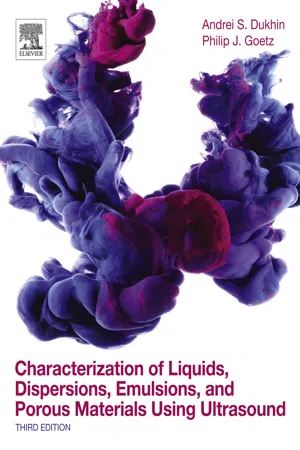Chemistry
pH Curves and Titrations
pH curves and titrations are used to determine the concentration of an unknown solution by reacting it with a solution of known concentration. The pH curve shows the change in pH as the titrant is added, and the equivalence point is where the moles of acid and base are equal. Titrations are important in determining the acidity or basicity of a solution.
Written by Perlego with AI-assistance
Related key terms
8 Key excerpts on "pH Curves and Titrations"
- eBook - ePub
- James F. Pankow(Author)
- 2019(Publication Date)
- CRC Press(Publisher)
For alkalimetric and acidimetric titrations, the titration curve is usually plotted as pH vs. amount (e.g., volume) of strong base or strong acid added. Here, however, since we want to discuss things in a general context, for the x -axis rather than volume, we will mostly use the value of C B − C A that is produced in the solution (or the related parameter f, defined below). If the concentration in the titrant is sufficiently large relative to the concentration of what is being titrated (say 20×), then near-constancy in the value of A T (or B T, etc.) in the solution can be assumed over the course of the titration: the volume of titrant added does not significantly increase the volume of solution being titrated so that A T (or B T, etc.) is not significantly lowered during the titration. This assumption simplifies computing titration curves. While the mathematics of titrations might be viewed as, well, tedious and confusing, it is fundamentally important for understanding how aqueous solutions behave in response to changes in acid or base content. First, most of the salt in the oceans is the result of the grand back-and-forth chemical neutralization that has occurred over geologic time of metal oxide bases from terrestrial solids reacting with added HCl from volcanism and vice versa (Schilling et al., 1978). Second, natural waters undergo titration changes whenever there are spills of strong acid or base, and when acid rain falls on a lake watershed system. Third, laboratory titrations are routinely used in analytical determinations of “alkalinity” in samples of: (1) natural water; and (2) water flowing through waste and drinking water treatment plants, to provide input information for calculations regarding pH control - eBook - ePub
- Andrei S. Dukhin, Philip J. Goetz(Authors)
- 2010(Publication Date)
- Elsevier(Publisher)
Chapter 11 Titrations Andrei S. Dukhin and Philip J. Goetz Publisher Summary The chapter presents information on titrations. Ultrasound-based methods are especially suitable for titrations because they do not require sample dilution and allow mixing. As a result, practically all ultrasound-based instruments are equipped with titrators. The chapter discusses four different titration types : pH titration, surfactant titration, salt titration, and time titration; hence, this is essentially a kinetic study. The chapter also discusses three major factors that must be taken into account for performing a proper titration experiment: (1) Agitation, (2) Equilibration time, and (3) Background electroacoustic subtraction. The chapter discusses the most widely known version of colloidal titration: pH titration. In this case, acid and/or base are the chemicals used to affect the chemical composition of the colloid—namely, the pH value. Automatic “surfactant titration” is a simple way for determining the optimum dose of surfactant required to stabilize the system. In this case, a surfactant solution of specific concentration is automatically dispensed by a burette. Webster’s dictionary [ 1 ] gives the definition of the word “titration” as it relates to general chemistry as “the process of finding out how much of a certain substance is contained in a solution by measuring how much of another substance it is necessary to add to the solution in order to produce a given reaction.” This term has a slightly different meaning in colloid chemistry. It emphasizes the second part of Webster’s definition: observing the reaction caused by adding a certain substance to the solution. Colloid chemistry deals with interfaces, and consequently the reaction of interest must somehow be related to the surface properties. An obvious “reaction” is the change in ς-potential due to additions to the chemical composition - Stig Pedersen-Bjergaard, Bente Gammelgaard, Trine G. Halvorsen(Authors)
- 2019(Publication Date)
- Wiley(Publisher)
Compared to indicator endpoint detection, potentiometric endpoint detection has a slightly slower response time. That is, there is often a slight delay from the addition of titrant until the reading of the voltmeter has stabilized. For this reason, the titrant is added slowly when approaching the endpoint.5.3 Aqueous Acid–Base Titrations
Most titrations of pharmaceutical ingredients are acid–base titrations. Acid–base titrations are used to assay basic or acidic pharmaceutical ingredients. In aqueous solution, strong acids and bases are entirely dissociated and the reaction for titration of a strong acid (titrate) with a strong base (titrant) is therefore(5.6)When a strong acid is gradually titrated with a strong base, pH changes according to Figure 5.6 . This curve is termed a titration curve. As appears from the titration curve, pH is very low in the strong acid titrate at the onset. At this point, the titrate comprises an aqueous solution of a strong acid. As titrant is added gradually, pH rises slightly due to the acid–base reaction. Just before the equivalence point, pH increases sharply, and in the equivalence point the stoichiometric reaction is complete. If the titration is continued after the equivalence point, the curve levels off at high pH values. Now, the titrate comprises an aqueous solution of a strong base, because the acid has been neutralized and the base is in excess. The equivalence point is located at the point of maximum slope of the titration curve and is the inflection point (point where curvature changes) of the curve.Figure 5.6Titration curve for titration of a strong acid (50 mL of 0.1 M HCl) with a strong base (0.2 M NaOH)To detect the endpoint of an acid–base titration visually, a colour indicator can be added to the titrate to perform indicator endpoint detection. Colour indicators of acid–base titration are acidic or basic substances, which change colour as they are transformed to their basic or acidic form, respectively. An example of an acid–base indicator is phenolphthalein, which is shown in Figure 5.7 . Phenolphthalein has a pKa value of 9.4. Thus, at pH 9.4, 50% of the indicator is in acidic form and 50% is in basic form. At this pH, the indicator is coloured pink. At pH 8.4 only 10% of the indicator is in basic form and the pink colour is very weak, while at pH 10.4 about 90% of the indicator is in basic form and the pink colour is very intense. In practice, the colour change of phenolphthalein is seen clearly between pH 8.4 and 10.4. From the titration curve in Figure 5.6 , it appears that pH rises very rapidly from about pH 4 to 12 around the equivalence point. With the presence of phenolphthalein in the titrate, the colour changes from colourless to pink at the equivalence point. This colour shift serves as endpoint detection, the addition of titrant is terminated, and the volume of titrant is read. Based on this volume, the result of the assay is calculated as exemplified in Box 5.1- eBook - ePub
Aquatic Chemistry
Chemical Equilibria and Rates in Natural Waters
- Werner Stumm, James J. Morgan(Authors)
- 2012(Publication Date)
- Wiley(Publisher)
2 L respectively, and correspond to minima in the buffer intensity. The smaller the buffer intensity, the steeper is the titration curve.Similarly, the equation describing the acidimetric titration curve of the base ML (where M+ does not protolyze) can be derived from the concentration condition 79 and the electroneutrality condition:(83)The morphology of the titration curve is given by(84a)The alkalimetric or acidimetric titration of the ampholyte HL is described simply by the appropriate portions of equations 82 and 84a , respectively.For a mixture of protolysis systems, the variation in [H+ ] as a result of the addition of strong acid and/or strong base can be defined by(84b)3.9 BUFFER INTENSITY AND NEUTRALIZING CAPACITY
The slope of a titration curve (pH versus CB ) is related to the tendency of the solution at any point in the titration curve to change pH upon addition of base. The buffer intensity at any point of the titration is inversely proportional to the slope of the titration curve at that point and may be defined as(85)where dCB and dCA are the numbers of mol liter−1 of strong acid or strong base required to produce a change in pH of d pH. β has also been called the buffer capacity or the buffer index.Buffer Intensity
Obviously the buffer intensity can be expressed numerically by differentiating the equation defining the titration curve with respect to pH. For a monoprotic acid–base system (see equations 67 and 69 - eBook - ePub
- Clyde Frank(Author)
- 2012(Publication Date)
- Academic Press(Publisher)
Since the two are strong electrolytes, they are completely ionized. In contrast, a weak acid–strong base titration is characterized by three different ionization effects. The initial pH of the weak acid solution is given by the K a expression (Example 8-1). The instant base is added, and until the stoichiometric point is reached, the solution is a buffer (Example 8-9). At the stoichiometric point a salt of a strong base–weak acid is formed and therefore, the pH of the solution is determined by the presence of a conjugate base of moderate strength which undergoes hydrolysis (Example 8-7). After the stoichiometric point, excess strong base is added and the excess determines the pH of the solution. A flow sheet on pages 158 and 159 provides the equations for the complete calculation of the two types of titration curves. Figure 8-1 shows a calculated titration curve for the HCl–NaOH titration plotted vs ml of NaOH and percent neutralized. The titration break is very sharp and at the stoichiometric point the pH changes approximately by 8 pH units for a small fraction of added titrant. It is this sharp change that is to be detected as the end point. Fig. 8-1 Calculated titration curve for the titration of 40.0 ml of 0.100 F HCl with 0.100 F NaOH. The effect of dilution on the titrant and sample is illustrated by the dotted lines. The concentration of the strong acid and strong base influences the shape of the titration curve. Figure 8-2 also illustrates this concentration effect As the concentration of the system decreases, the magnitude of the pH break decreases. (The stoichiometric point is always at pH = 7.) Thus, the ability to select the end point becomes impaired. If the titration is being used for analysis, the lower concentration limits, particularly if a weak acid or a weak base is being titrated, are about 0.001 F. Fig - eBook - ePub
- James N. Butler(Author)
- 2019(Publication Date)
- Routledge(Publisher)
CHAPTERTHREE The AlkalinityTitration CurveIn Chapter 2 , alkalinity was defined in terms of a model containing only CO2 and NaOH in solution:A = [HCO 3 -] + 2 [CO 3 -] + [OH -] - [H +](2.16) or (3.1) If such a solution is titrated with HCl or other strong acid to the pH (approximately 4.5) corresponding to pure CO2 and H2 O, the amount of acid added will be equivalent to A, or Ac , the carbonate alkalinity.In a natural water, other acids and bases may contribute to the reaction with HCl and produce a titer that is usually greater than the carbonate alkalinity. This empirical measure is called total alkalinity AT . Before I go into details of how various additional components may affect the total alkalinity and the shape of the titration curve, I want to derive the shape of the titration curve for a solution containing only NaOH and CO2 . The equation governing this curve is closely related to Eq. (2.28 ) p. 26 .THE TITRATION CURVE EQUATIONLet Vo be the initial volume of the sample, which contains alkalinity A and total carbonate CT (these two values will determine the initial pH, so it cannot be specified in addition). Let the titrant be a strong acid (HCl) of concentration Ca , and the volume be V. Then the various concentrations in the charge balance (Eq. (2.17 )) can be specified in terms of the parameters listed above and the variable [H+ ]:
with[Na +] + [H +] = [Cl -] + [HCO 3 -] + 2 [CO 3 =] + [OH -] ,(2.17) or (3.2) [Na +] =,AV 0V +V 0(3.3) [Cl -] =,C aVV +V 0(3.4) [OH -] =K w[H +](3.5) [andHCO 3 -][are given by Eqs. (2.21 ) and (2.22 ) with CT multiplied by V0 /(V + V0 ) to correct for dilution. Substitute these together with (3.3 ), (3.4 ), and (3.5 ) in (3.2CO 3 =] - eBook - ePub
- Andrei S. Dukhin, Philip J. Goetz(Authors)
- 2017(Publication Date)
- Elsevier(Publisher)
Chapter 11 Titrations Abstract Webster's dictionary [1] gives a definition of the word “titration” as “…the process of finding out how much of a certain substance is contained in a solution by measuring how much of another substance it is necessary to add to the solution in order to produce a given reaction.” This term has a slightly different meaning in colloid chemistry; an obvious “reaction” is the change in ζ-potential due to additions to the chemical composition. We discuss here examples of pH titration, surfactant titration, and salt titration. Evolution of the sample in time can be considered as kinetic titration. There is a special section on importance of the proper sample agitation during titration and various means of conducting such agitation. Keywords Acoustics; Aggregative stability; Attenuation; Colloid; Dispersion; Double layer; Electroacoustics; Electrochemistry; Electrophoresis; Electrophoretic mobility; Emulsion; High ionic strength; Ionic strength; Nanoparticle; Nanotechnology; pH titration; Salt titration; Soft particle; Sound speed; Surfactant titration; Ultrasound; ζ-Potential Webster's dictionary [1] gives a definition of the word “titration” as it relates to general chemistry as “…the process of finding out how much of a certain substance is contained in a solution by measuring how much of another substance it is necessary to add to the solution in order to produce a given reaction.” This term has a slightly different meaning in Colloid Chemistry. It emphasizes the second part of Webster's definition: observing the reaction caused by adding a certain substance to the solution. Colloid Chemistry deals with interfaces, and consequently the reaction of interest must somehow be related to the surface properties. An obvious “reaction” is the change in ζ-potential due to additions to the chemical composition - eBook - ePub
Chemistry
Concepts and Problems, A Self-Teaching Guide
- Richard Post, Chad Snyder, Clifford C. Houk(Authors)
- 2020(Publication Date)
- Jossey-Bass(Publisher)
13 Acids and BasesChapters 11 and 12 gave you an indication that all acids have certain properties in common and all bases have certain properties in common. The major common property is that acids react with bases (and vice versa) to produce salts. For example, if solutions of HCl (an acid) and KOH (a base) are mixed, the following reaction occurs.Such a reaction gives a solution that no longer has the acidic or basic properties that were evident before mixing, provided the correct volumes and concentrations were used.What then is an acid? What is a base? There are three definitions that have been developed through the years. Each has its own particular usefulness, depending upon the nature of the reactants and the conditions of the reaction. In this chapter we will discuss each of the definitions and their particular usefulness.Our discussion of acids and bases will touch on several other important concepts, including reactions of salts with water, another concentration term specially developed for acid–base solutions, and the importance of acid–base chemistry to physiological and industrial processes.OBJECTIVES
After completing this chapter, you will be able to- recognize and apply or illustrate the following: Arrhenius, Brønsted–Lowry, and Lewis acids and bases, neutralization, hydrolysis, pH, buffer solution, titration, conjugate acid or base, amphiprotic, indicator, hydronium ion, and hydrated;
- write a chemical equation for a neutralization reaction between any acid and base;
- predict whether a solution of a given salt will be acidic, basic, or neutral;
- calculate the pH of a solution when given:
- the degree of ionization of a weak acid or base and vice versa,
- Kaor Kbof the acid or base and vice versa,
- the concentration of a solution of a strong acid or base;
- solve titration problems.
ARRHENIUS ACIDS AND BASES
There are several chemical theories of acids and bases. The most familiar is that of Arrhenius. According to the Arrhenius definition, an acid is any substance that produces or increases the H+ ion concentration in an aqueous solution (remember, water is the solvent). Both HCl and HC2 H3 O2 can increase the H+ ion concentration of water. Do HCl and HC2 H3 O2
Index pages curate the most relevant extracts from our library of academic textbooks. They’ve been created using an in-house natural language model (NLM), each adding context and meaning to key research topics.







